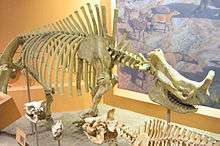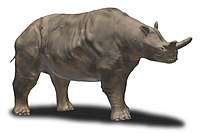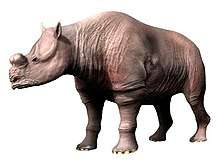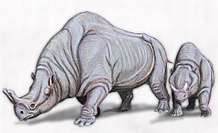Brontotheriidae
Brontotheriidae, also called Titanotheriidae, is a family of extinct mammals belonging to the order Perissodactyla, the order that includes horses, rhinoceroses, and tapirs. Superficially, they looked rather like rhinos, although they were actually more closely related to horses; Equidae and Brontotheriidae make up the suborder Hippomorpha. They lived around 56–34 million years ago, until the very close of the Eocene.
| Brontotheres | |
|---|---|
 | |
| Brontotherium hatcheri skeleton at the National Museum of Natural History, Washington, DC | |
| Scientific classification | |
| Kingdom: | Animalia |
| Phylum: | Chordata |
| Class: | Mammalia |
| Order: | Perissodactyla |
| Family: | †Brontotheriidae Marsh, 1873 |
| Genera | |
|
See text | |
| Synonyms | |
| |
Characteristics and evolution
Brontotheres retain four toes on their front feet and three toes on their hind feet. Their teeth are adapted to shearing (cutting) relatively nonabrasive vegetation. Their molars have a characteristic W-shaped ectoloph (outer shearing blade).
The evolutionary history of this group is well known due to an excellent fossil record in North America.[1] The earliest brontotheres, such as Eotitanops, were rather small, no more than a meter in height, and hornless.
Brontotheres evolved massive bodies, although some small species such as Nanotitanops did persist through the Eocene. Some genera, such as Dolichorhinus, evolved highly elongated skulls. Later brontotheres were massive, up to 2.5 m (8.2 ft) tall with horn-like skull appendages. The North American brontothere Megacerops, for example, evolved large sexually dimorphic paired horns above their noses. The sexually dimorphic horns suggest that brontotheres were highly gregarious (social) and males may have performed some sort of head-clashing behavior in competition for mates. Unlike rhinoceros, in which the horns are made of keratin, however, the horns of brontotheres are composed of bone (the frontal bone and nasal bone) and were placed side-to-side rather than front-to-back.
Brontotheres probably became extinct because they could not adapt to drier conditions and tougher vegetation (such as grasses) that spread during the Oligocene.[1]
Classification of Brontotheres
|
Two classification systems for Brontotheriidae are presented below. The first contains 43 genera and 8 subfamilies, and although it is based on a 1997 publication by McKenna and Bell, it summarizes research that was conducted before 1920 and is badly outdated. The second classification is based on 2004 and 2005 research by Mihlbachler et al., which indicates that many of the previous subfamily names are invalid. Several more recently discovered brontotheres are included in the newer classification.
Although Lambdotherium and Xenicohippus were previously included in Brontotheriidae, they are no longer considered members of this family. Lambdotherium, though excluded, may be the closest known relative to brontotheres. Xenicohippus is now thought to be an early member of the horse family, Equidae.
| Old Classification (summarized by McKenna and Bell, 1997) | New classification (Mihlbachler et al., 2004a, 2004b; Mihlbachler, 2005) |
|---|---|
|
|
Notes
- Titanotherium
- Mihlbachler, Matthew C. "Species taxonomy, phylogeny and biogeography of the Brontotheriidae (Mammalia, Perissodactyla)". Bulletin of the American Museum of Natural History. American Museum of Natural History (311). Retrieved 4 September 2013.
- Mader, Bryn J. "A species-level revision of the North American brontotheres Eotitanops and Palaeosyops (Mammalia, Perissodactyla)" (PDF). Department of Biological Sciences and Geology, Queensborough Community College. Retrieved 4 September 2013.
References
- McKenna, M.C.; Bell, S.K. (1997). Classification of Mammals Above the Species Level. New York: Columbia University Press. ISBN 0231110138. OCLC 37345734.CS1 maint: ref=harv (link)
- Mihlbachler, M.C. (2004). Phylogenetic Systematics of the Brontotheriidae (Mammalia, Perissodactyla) (Ph.D. thesis). Columbia University.
- Mihlbachler, M.C.; Lucas, S.G.; Emry, R.J. (2004a). "The holotype specimen of Menodus giganteus, and the 'insoluble' problem of Chadronian brontothere taxonomy". In Lucas, S.G.; Zeigler, K.; Kondrashov, P.E. (eds.). Paleogene Mammals. Bulletin 26. New Mexico Museum of Natural History and Science. pp. 129–136. Retrieved 29 October 2013.CS1 maint: ref=harv (link)
- Mihlbachler, M.C.; Lucas, S.G.; Emry, R.J.; Bayshashov, B. (2004b). "A new brontothere (Brontotheriidae, Perissodactyla, Mammalia) from the Eocene of the Ily Basin of Kazakhstan and a phylogeny of Asian "horned" brontotheres" (PDF). American Museum Novitates. 3439: 1–43. doi:10.1206/0003-0082(2004)439<0001:ANBBPM>2.0.CO;2. Retrieved 29 October 2013.CS1 maint: ref=harv (link)
External links
- Brontotheroidea at Mikko's Phylogeny Archive


-PaleozoologicalMuseumOfChina-May23-08.jpg)
